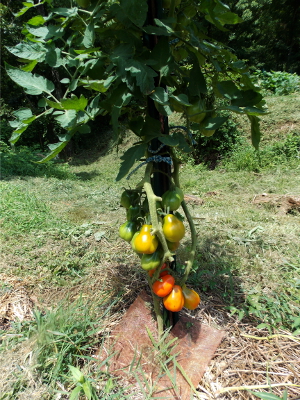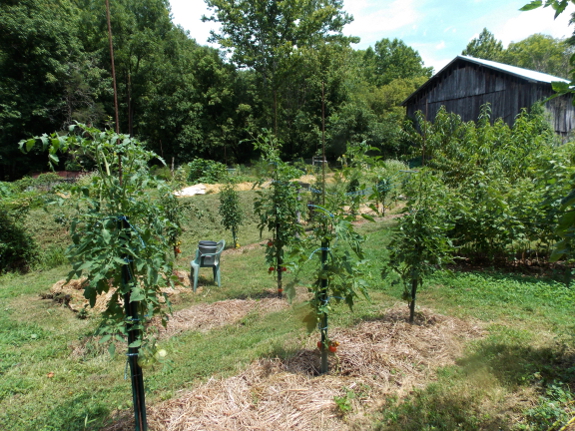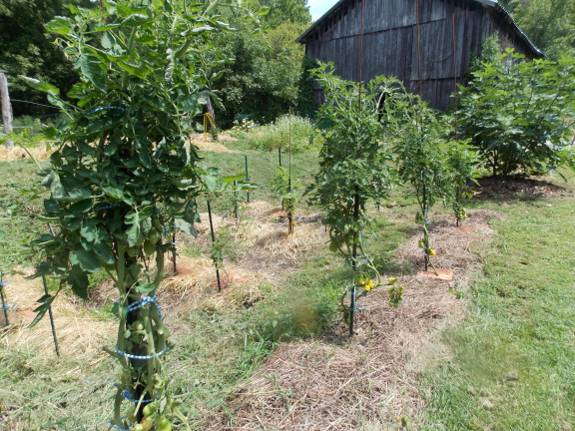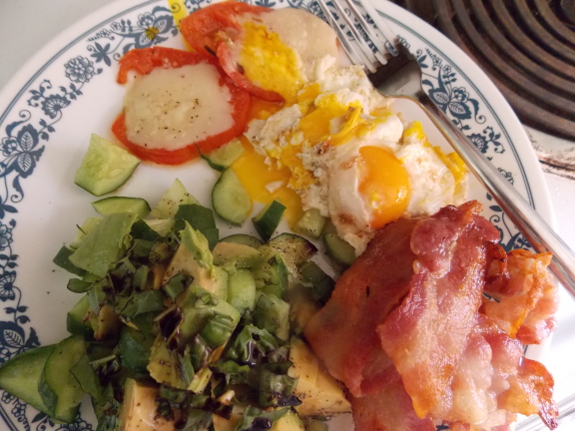
Tomato copper experiment: Inconclusive
 Even though I had steeled myself for the
tomato blight to hit early and hard in this wet summer, it still
hurt when the fungi took over our planting this week. We've
frozen a grand total of three pints of tomato-based soup so far,
and it's looking like this major component of our winter diet will
be scanty in 2013. (I still hope to put away a few gallons
of soup from the tomatoes ripening now, and the ones I'll end up
ripening inside once the blight beats my radical
pruning and
takes the vines, but it'll be much less than usual.)
Even though I had steeled myself for the
tomato blight to hit early and hard in this wet summer, it still
hurt when the fungi took over our planting this week. We've
frozen a grand total of three pints of tomato-based soup so far,
and it's looking like this major component of our winter diet will
be scanty in 2013. (I still hope to put away a few gallons
of soup from the tomatoes ripening now, and the ones I'll end up
ripening inside once the blight beats my radical
pruning and
takes the vines, but it'll be much less than usual.)
On the positive side,
we don't need nearly as much frozen food to take us through the
winter any more. Between our $10
root cellar, quick
hoops, and the discovery of brussels
sprouts, we fill at least half of our winter vegetable needs
with fresh, living food. Plus, gallons of fruit leather,
sauces, and jams should sweeten my winter disposition even without
the taste of summer tomatoes.

Still, it's worth
taking a minute to sum up factors I could change to slow the
spread of blight in later years. Even though weather is the
biggest reason our tomatoes are failing, I made a major blunder in
selecting their location this year, placing nearly half of our
plants in the gully. During a normal year, the gully would
have provided a sunny spot that was subirrigated,
allowing me to grow tomatoes without risking blight during
watering. But during a wet year, the gully turned out to be
a reservoir of infection. The first signs of blight showed
up there, and none of the plants in the gully did well. In
fact, our copper
experiment was
completely inconclusive because the primary factor that determined
blight damage this year has been proximity to those disease
carriers in the gully.

You can get an idea
for the difference between gully tomatoes and non-gully tomatoes
in the photo above. The plants in the background are in the
lowest part of the gully and have basically been pruned down to
nothing because of major blight damage. In contrast, the
foreground plants are much taller and have quite a few healthy
leaves left.
I could probably turn the gully into an okay tomato spot by
raising the beds up about two feet off the ground, but chances are
I'll just come up with another location for tomatoes in 2016,
after rotating our tomato plot through the back garden and the
forest garden.

In the meantime, I'm
drowning my sorrows in other parts of the summer bounty.
Even a few tomatoes are delicious when fried and topped with swiss
cheese, parmesan, salt, and pepper. An influx of pullet eggs
and cucumbers reminds me that tomatoes aren't the be-all and
end-all of gardening life, even if they sometimes feel that way.
Want more in-depth information? Browse through our books.
Or explore more posts by date or by subject.
About us: Anna Hess and Mark Hamilton spent over a decade living self-sufficiently in the mountains of Virginia before moving north to start over from scratch in the foothills of Ohio. They've experimented with permaculture, no-till gardening, trailersteading, home-based microbusinesses and much more, writing about their adventures in both blogs and books.
Want to be notified when new comments are posted on this page? Click on the RSS button after you add a comment to subscribe to the comment feed, or simply check the box beside "email replies to me" while writing your comment.
- Remove comment
